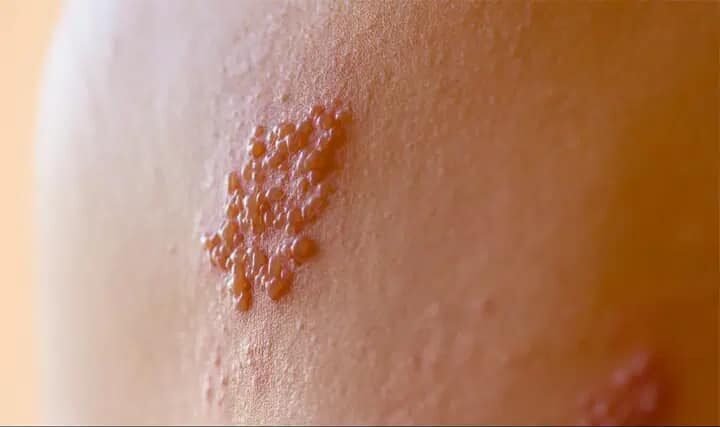Shingles (herpes zoster) is a painful rash caused by the reactivation of the varicella-zoster virus (the same virus that causes chickenpox). While shingles often resolves on its own, some symptoms can signal serious complications. Here are the symptoms you should never ignore:
1. Severe Pain Before the Rash Appears
-
Burning, tingling, or extreme sensitivity on one side of the body (often the torso, face, or eye area) can occur days before the rash develops.
-
Why it’s serious: Early nerve pain can indicate nerve damage (postherpetic neuralgia) if untreated.
2. Rash Near the Eye (Ophthalmic Shingles)
-
Blisters on the forehead, nose, or around the eye (herpes zoster ophthalmicus).
-
Why it’s serious: Can lead to vision loss, corneal damage, or glaucoma if not treated promptly.
3. Rash on the Face or Ear (Ramsay Hunt Syndrome)
-
Rash in/around the ear, face, or mouth, accompanied by hearing loss, dizziness, or facial paralysis.
-
Why it’s serious: Can cause permanent hearing loss or Bell’s palsy.
4. Widespread Rash (Disseminated Shingles)
-
A rash that spreads beyond one side of the body (like chickenpox).
-
Why it’s serious: May indicate a weakened immune system (e.g., HIV, cancer, or autoimmune disease).
5. High Fever or Fatigue with Shingles
-
Fever over 101°F (38.3°C), chills, or severe exhaustion.
-
Why it’s serious: Could signal a secondary bacterial infection or systemic involvement.
6. Confusion, Headache, or Stiff Neck
-
These symptoms, especially in older adults, may indicate encephalitis or meningitis.
-
Why it’s serious: Life-threatening if untreated.
7. Persistent Pain After Rash Heals (Postherpetic Neuralgia – PHN)
-
Pain lasting months or years after the rash disappears.
-
Why it’s serious: Chronic nerve pain can severely impact quality of life.
When to Seek Emergency Care
🚨 Go to the ER or call a doctor immediately if you have:
-
Shingles near the eye or ear.
-
A widespread, blistering rash.
-
Signs of infection (pus, swelling, fever).
-
Neurological symptoms (confusion, severe headache, weakness).
Prevention & Treatment
-
Vaccine: The Shingrix vaccine (recommended for adults 50+ and immunocompromised individuals).
-
Antivirals: Medications like acyclovir or valacyclovir can shorten the outbreak if taken early.
-
Pain Management: NSAIDs, gabapentin, or lidocaine patches may help.
Don’t ignore these symptoms—early treatment can prevent complications! If you suspect shingles, see a doctor within 72 hours for the best outcomes.
Would you like more details on treatments or risk factors?
Here’s a deeper dive into shingles treatments, risk factors, and long-term management to help you stay informed and proactive:
1. Who’s at Highest Risk?
-
Age 50+: Risk increases significantly with age (immune system weakens over time).
-
Weakened Immunity: People with HIV, cancer (especially chemotherapy), autoimmune diseases (e.g., lupus, rheumatoid arthritis), or chronic stress.
-
Previous Chickenpox Infection: The virus lies dormant in nerves and can reactivate decades later.
-
Certain Medications: Long-term steroids or immunosuppressants (e.g., after organ transplants).
2. How Is Shingles Diagnosed?
-
Visual Exam: Doctors usually diagnose shingles based on the unilateral rash and pain pattern.
-
Lab Tests: Rarely needed, but a PCR test or viral culture can confirm (e.g., for atypical cases).
3. Medical Treatments (Start ASAP!)
Antiviral Medications (Most effective within 72 hours of rash onset)
-
Acyclovir (5x/day for 7–10 days)
-
Valacyclovir (3x/day for 7 days) – More convenient, better absorption.
-
Famciclovir (3x/day for 7 days)
Why they matter: Reduce rash duration, pain severity, and risk of complications like PHN.
Pain Management
-
Over-the-counter: Acetaminophen, ibuprofen, or naproxen.
-
Prescription Options:
-
Gabapentin/Pregabalin: For nerve pain.
-
Lidocaine patches: Numb the affected area.
-
Capsaicin cream: Helps desensitize nerves (use after blisters heal).
-
Steroids: Short-term use for severe inflammation (controversial—not always recommended).
-
For Eye or Ear Involvement
-
Ophthalmic shingles: Urgent referral to an ophthalmologist + antiviral eye drops.
-
Ramsay Hunt Syndrome: May require steroids + antivirals to prevent permanent facial nerve damage.
4. Postherpetic Neuralgia (PHN) – Long-Term Pain
-
What it is: Pain lasting >3 months after the rash heals (affects ~10–20% of shingles patients).
-
Treatments:
-
Antidepressants (e.g., amitriptyline) – Helps block pain signals.
-
Nerve blocks (injections) for severe cases.
-
TENS units (electrical nerve stimulation).
-
5. How to Prevent Shingles
-
Shingrix Vaccine:
-
Recommended for: Adults 50+ and immunocompromised adults 19+.
-
Dose: 2 shots, 2–6 months apart.
-
Effectiveness: >90% at preventing shingles and PHN.
-
-
Avoid Triggers: Stress, illness, or poor sleep can reactivate the virus.
6. Home Care & Natural Remedies
-
Cool compresses: Soothe blisters (avoid scratching to prevent infection).
-
Oatmeal baths: Calm itchy skin.
-
Vitamin B12 & Lysine: Some evidence supports nerve repair and viral suppression.
-
Stress reduction: Yoga, meditation (stress weakens immunity).
When to Follow Up with a Doctor
-
Rash isn’t improving after 10 days.
-
New blisters appear after scabbing.
-
Signs of infection (red streaks, pus, fever).
-
PHN pain interferes with daily life.
Key Takeaway
Early treatment with antivirals is critical to reduce complications. If you’re eligible, get vaccinated—Shingrix is the best defense.
Would you like guidance on talking to a doctor about shingles or vaccine access? I’m happy to help! 😊
